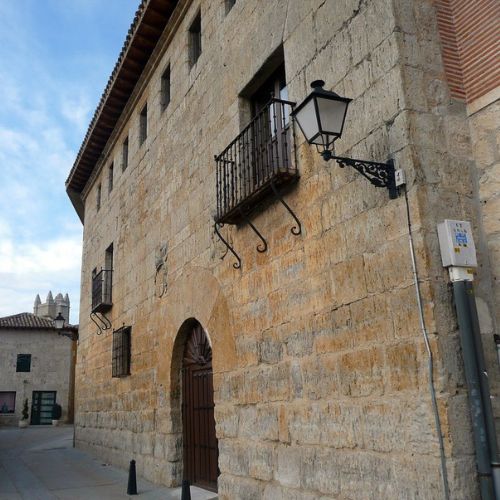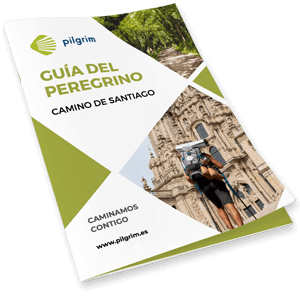Castrojeriz
‹ Back to the stage
Castrojeriz
- Residents: 845 aprox.
- Province: Burgos
Information
Get to know Castrojeriz
This small village is located next to the Odra River in the middle of the French Way, so that since the discovery of the tomb of St. James receives a large number of pilgrims.
That is why in the past travelers arriving in the village were surprised to find the magnificent pilgrim hospital of San Antón, one of the most important points of the Camino de Santiago.
Location
How to get there
The main way to get to the village of Castrojeriz is by the A-231 highway that connects Burgos and León, passing Sasamón you have to take the N-12 to Villasandino and there finally take the BU-404 to reach the village. If you are coming from Madrid, the ideal is to take the E-1 road to Lerma, then take the N-622 and connect with the E-80 towards Burgos and Villaquirán de los Infantes take the BU-400.
By public transport the easiest and most advisable option is to get to Burgos and once in the city take a bus that connects daily Burgos with Castrojeriz, although there are also lines from Frómista.
History / Culture
What to see
Casa Gutierrez Barona
The Gutiérrez Barona House is located in the neighborhood of San Juan and stands out among the buildings commissioned by the nobility to the stonemasons. This house was built at the end of the 14th century, although it later changed owners and underwent some modifications.
At present, the building was fitted out to house a residence for the elderly.

Museo Etnográfico
This Ethnographic Museum is located in a house donated by Doña Josefina González Santos since 1999. It was created with the aim of showing the daily life and customs of the villagers who once lived in Castrojeriz.

Plaza Mayor y Ayuntamiento
The Plaza Mayor is located in the center of the town of Castrojeriz presided over by the Town Hall building.
This is where the town’s markets were held and still preserves the remains of columns dating from the sixteenth century. The town hall building belongs to the seventeenth century, although it has been renovated inside to perform administrative work and housing the archives and municipal offices.

Iglesia de Santo Domingo
The Church of Santo Domingo presents a mixture of several architectural styles, although its general structure is of Gothic style. Of neoclassical style, it has the vaults that cover it as well as the main altarpiece that presides over its chancel. Of plateresque style stands out the access doorway of the XVI century.

Iglesia de San Miguel de Tabanera
The Church of San Miguel de Tabanera was built by order of Isabel de Padilla in 1607, after the church in the same place had collapsed. The construction was carried out by reusing the stones of the original church and preserving forms of the structure, such as, for example, the second floor of the tower. This has a square floor plan with lateral openings without windows and is covered with a pointed dome, built with granite ashlars.

Iglesia de la Virgen del Manzano
The Virgen del Manzano Church was built in the year 1214 during the Gothic transition, but underwent successive reforms being the most outstanding one in the eighteenth century. In this reform the following extensions were carried out: the chapel of the Virgen del Manzano was erected, the crypt in which the counts were buried was excavated, its new apse was placed and the new tower was erected.
At present, the interior houses the Museum of Sacred Art in which different medieval sculptures, Flemish paintings, parchments, etc.
.

Hospital General San Antón
The General Hospital San Antón, built in the 14th century with the purpose of welcoming and caring for pilgrims, is located on the outskirts of Castrojeriz on the route of the French Way, so that pilgrims met the hospital before reaching the center of the town.
The Hospital General San Antón, built in the 14th century with the purpose of welcoming and caring for pilgrims, is located on the outskirts of Castrojeriz on the route of the French Way, so that pilgrims met the hospital before reaching the center of the town.

Convento de Santa Clara
The Convent of Santa Clara is in the rural gothic style of Burgos and underwent its last major renovation in the eighteenth century. This construction before 1326, the year in which the order of the Poor Clares moved its headquarters to the Convent, belonged to the Franciscans. At that time, when the mothers moved, they decided to start offering laundry and bakery services in order to obtain economic benefits to keep the building standing.
In 1976 the Poor Clare Community celebrated 650 years of permanence in this village.

Iglesia de San Juan
The church of San Juan was the work of Rodrigo Gil de Hontañón in the 16th century, in the German Gothic style. It is characteristic of this style that the three naves of the church were arranged at the same height as the central nave, as is the case in this church.
In the interior of the temple we find a small cloister of the fourteenth century and two side chapels dedicated to Santa Ana and Dulce Nombre de Jesús. The main altarpiece of baroque style and the side altarpiece of plateresque style dedicated to Santa Ana crowns its chancel.

Claustro de la Iglesia de San Juan
The cloister of the Church of San Juan was built in the sixteenth century over another original fifteenth century Gothic style. Today, the cloister retains the three eastern wings and the Mudejar murals with which its columns were covered.

Arcos del Monasterio de San Francisco
From the Arch of the Monastery of San Francisco, from the 14th century, only some remains are preserved. This Franciscan monastery was built in the middle of the French Way in order to house the college and novitiate, but it was only until the fifteenth century, since with the arrival of the disentailment of Mendizabal it was abandoned.

Museo del Arte Sacro
The Museum of Sacred Art is located inside the Church of the Virgin Santa Maria del Mandazo and has been built with the purpose of showing different sculptures, carvings and paintings found inside, such as the Rococo altarpiece of the main altar, the tombs of the Counts of Castro, paintings by Berruguete, Diego de Siloé, Carducho, etc..

Information of interest
Local police
112
Civil guard
947 377 031
Fire department
947 278 700
Civil protection
112
Town hall
947 377 001
Health center
947 377 020
Tourism office
947 370 701
Plaza Mayor, 1

We send you your itinerary
Enter your details and receive your travel itinerary by email
Recommended
Gastronomy
Recommended
Festivals and Pilgrimages
Local festivity
Primera semana de Septiembre: El Sejo
Local festivity
23 de Junio: San Juan
Local festivity
Mediados de Julio hasta finales de Agosto: Feria del Ajo
French Way
On foot
33 stages



































